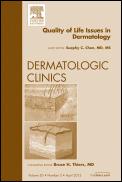
DERMATOLOGIC CLINICS
Scope & Guideline
Empowering Clinicians with Essential Dermatological Research
Introduction
Aims and Scopes
- Clinical Management of Skin Conditions:
The journal publishes articles that focus on the diagnosis, management, and treatment of common and complex skin disorders, ranging from atopic dermatitis to psoriasis and various forms of dermatitis. - Patient-Centric Research and Quality of Life Assessments:
A significant emphasis is placed on understanding the patient burden associated with dermatological diseases and the impact of these conditions on the quality of life, as well as exploring patient education and self-management strategies. - Emerging Therapies and Treatment Paradigms:
DERMATOLOGIC CLINICS highlights advancements in treatment methodologies, including biologics, systemic therapies, and innovative cosmetic procedures, aiming to provide dermatologists with the latest evidence-based practices. - Diversity and Equity in Dermatology:
The journal addresses the importance of diversity, equity, and inclusion within dermatology, exploring disparities in care and outcomes for different racial and ethnic groups. - Interdisciplinary Approaches to Dermatological Issues:
The journal often integrates insights from related fields such as immunology, oncology, and public health, reflecting a holistic approach to dermatological care.
Trending and Emerging
- Atopic Dermatitis and Related Comorbidities:
A significant increase in publications focusing on atopic dermatitis, its management, and associated comorbidities indicates a growing recognition of its complexity and the need for multidisciplinary approaches. - Impact of Social Determinants on Dermatology:
Emerging themes around how social determinants of health affect dermatological outcomes and access to care are gaining prominence, highlighting the importance of addressing systemic issues within dermatology. - Teledermatology and Digital Health Innovations:
With the rise of telemedicine, there is a trend towards exploring digital health solutions and their impact on dermatological care, especially in the wake of the COVID-19 pandemic. - Diversity and Inclusion in Dermatology:
A growing focus on diversity, equity, and inclusion within dermatology practices and research is evident, addressing disparities faced by underrepresented groups in dermatological health outcomes. - Advancements in Psoriasis Treatment Strategies:
There is a notable trend towards discussing the latest advancements in psoriasis, including biologics and personalized medicine, reflecting the rapid progress in treatment options.
Declining or Waning
- Traditional Cosmetic Procedures:
There has been a noticeable decrease in articles solely focused on traditional cosmetic procedures, as the journal shifts towards more innovative and evidence-based approaches in aesthetic dermatology. - Vascular Anomalies and Related Conditions:
Research related to vascular anomalies, including hemangiomas and vascular malformations, appears to be waning, possibly as the field focuses more on broader dermatological conditions and systemic approaches. - Basic Dermatology Education for General Practitioners:
The journal seems to be moving away from articles that primarily focus on basic dermatology education for non-specialists, reflecting a trend towards more specialized and advanced topics.
Similar Journals

AUSTRALASIAN JOURNAL OF DERMATOLOGY
Transforming knowledge into clinical excellence.Australasian Journal of Dermatology is a leading publication in the field of dermatology, issued by Wiley since 1951, and reaching an audience of researchers, clinicians, and students interested in the latest advancements and practices in skin health. With an ISSN of 0004-8380 and an E-ISSN of 1440-0960, this journal stands out with its Q2 ranking in both Dermatology and Miscellaneous Medicine, positioning it within the top 61st percentile of its category according to Scopus. Although it does not provide Open Access options, Australasian Journal of Dermatology is committed to disseminating high-quality research that informs clinical practices and promotes scholarly dialogue. By publishing rigorous and peer-reviewed articles focused on various aspects of dermatological science, the journal plays a pivotal role in enhancing the dermatology community's understanding of skin conditions and treatments, making it an invaluable resource for professionals and students alike.
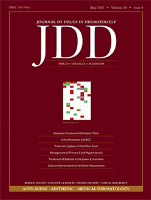
Journal of Drugs in Dermatology
Innovating skin therapies for a healthier tomorrow.Journal of Drugs in Dermatology, an esteemed publication in the field of dermatology, serves as a vital resource for researchers, clinicians, and healthcare professionals dedicated to advancing knowledge and practices in skin-related therapies and treatments. Established in 2002 and published in the United States, this journal focuses on a wide range of topics pertinent to dermatological pharmacology and therapeutics, reflecting contemporary scientific advancements and innovative approaches to patient care. With a strong presence in Scopus rankings, situating it at rank #73 within the dermatology category, and achieving a commendable Q2 quartile classification in both dermatology and general medicine categories, the journal is committed to enhancing understanding of drug efficacy and safety in dermatological conditions. While the journal maintains a traditional access model, its impact factor underscores its significance in the research community, supporting the ongoing dialogue between academia and clinical practice. We invite professionals and students alike to explore the latest findings and contribute to the progressive discourse on dermatological treatments through this important publication.

JOURNAL OF DERMATOLOGY
Illuminating the path to dermatological excellence.The Journal of Dermatology, published by Wiley, is a premier academic journal dedicated to advancing the field of dermatology, with its esteemed reputation reflected in its Q1 ranking in Dermatology and a remarkable Q2 ranking in Miscellaneous Medicine as of 2023. Since its inception in 1974, the journal has become a vital resource for researchers, clinicians, and students alike, covering pioneering studies and cutting-edge advancements in skin health and disease. With a Scopus rank of #32 out of 142 in the Dermatology category, placing it in the 77th percentile, the journal underscores its commitment to fostering knowledge and innovation within the dermatological community. Although the journal operates under a subscription model, it remains an essential platform for disseminating impactful research that shapes clinical practice and enhances patient care. For anyone invested in dermatological sciences, Journal of Dermatology serves as a key publication where critical insights and developments are regularly showcased.
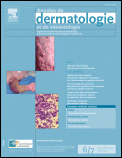
ANNALES DE DERMATOLOGIE ET DE VENEREOLOGIE
Your Gateway to Cutting-edge Dermatological InsightsANNALES DE DERMATOLOGIE ET DE VENEREOLOGIE is a distinguished journal that serves as a vital platform for disseminating innovative research and insightful reviews in the field of dermatology and venereology. Published by MASSON EDITEUR, this journal has been a cornerstone for professionals and researchers since its inception in 1977, offering a wealth of knowledge that spans decades. With its ISSN 0151-9638 and E-ISSN 2214-5451, it is indexed within leading databases, ensuring that the published work reaches a broad audience. The journal currently holds a Q3 ranking in the dermatology category, reflecting its commitment to quality and rigorous peer-review processes. While the journal is not open access, it provides an extensive archive of valuable studies that contribute to advancements in skin health and treatment methodologies. Located in Issy-les-Moulineaux, France, ANNALES DE DERMATOLOGIE ET DE VENEREOLOGIE continues to attract submissions from esteemed professionals, enhancing its reputation as a crucial resource for those dedicated to the ongoing development of dermatological sciences.

AMERICAN JOURNAL OF CLINICAL DERMATOLOGY
Advancing Clinical Insights for Healthier SkinThe American Journal of Clinical Dermatology, published by Adis International Ltd, is a leading peer-reviewed journal dedicated to advancing the field of dermatology. With a notable impact factor and a prestigious Q1 rank in both Dermatology and Miscellaneous Medicine categories, this journal stands out as a valuable resource for researchers and clinicians alike, offering cutting-edge insights into clinical practice and innovative treatment strategies. Its comprehensive scope encompasses a broad range of topics within dermatology, addressing both common and rare conditions, with a focus on emerging therapies and technologies. As it converges its publication years from 2000 to 2024, the journal remains an essential platform for disseminating high-quality research to professionals striving to improve patient care and outcomes. With the ISSN 1175-0561 and E-ISSN 1179-1888, the American Journal of Clinical Dermatology facilitates greater accessibility to pivotal findings within the field, making it an indispensable resource for anyone involved in dermatological research and practice.

BRITISH JOURNAL OF DERMATOLOGY
Leading the way in dermatology innovation.The British Journal of Dermatology, published by Oxford University Press, stands as a premier platform for advancing the field of dermatological research and clinical practice since its inception in 1892. With a strong commitment to disseminating high-quality research, this esteemed journal is currently ranked in the Q1 category for both Dermatology and Miscellaneous Medicine in 2023, reflecting its influential position in the academic landscape. As the leading journal in its field, it enjoys a robust Scopus ranking of #1 out of 142 in dermatology, placing it in the 99th percentile globally. The journal covers a wide scope of subjects pertinent to dermatology, including clinical trials, treatment innovations, and epidemiological studies, making it an essential resource for researchers, healthcare professionals, and students alike. Although it is not an open-access publication, it ensures a broad reach through institutional subscriptions, fostering knowledge exchange across the global dermatological community. Based in the heart of the United Kingdom, the British Journal of Dermatology continues to play a crucial role in shaping the future of skin health and disease management.

Dermatology and Therapy
Championing the latest in skin therapy advancements.Dermatology and Therapy is a prestigious Open Access journal, published by ADIS INT LTD since 2011, that has quickly established itself as a vital resource in the field of dermatology. With an impressive Q1 ranking in the Dermatology category as of 2023 and a commitment to disseminating high-quality research, this journal fosters innovation and knowledge exchange among professionals, researchers, and students alike. Its broad scope encompasses the latest advancements in dermatological therapies, contributing significantly to both clinical practice and academic research. Based in Germany and operating under a global perspective, Dermatology and Therapy provides an essential platform for open access research, encouraging unrestricted access to groundbreaking studies and fostering collaboration across borders. Join the community of dermatology experts by exploring the wealth of knowledge available in this influential journal.

Dermatologie
Elevating Dermatological Research and PracticeDermatologie, published by SPRINGER HEIDELBERG, is a prominent journal dedicated to the advancing field of dermatology. With its ISSN 2731-7005 and E-ISSN 2731-7013, this journal has established itself as a valuable resource for researchers, professionals, and students alike. Originating in Germany, the journal focuses on disseminating innovative research from 2022 to 2024, contributing significantly to the understanding of skin health and disease management. Despite its current ranking within the Q3 category in dermatology and a Scopus rank of #88/142, it provides critical insights and advances in clinical practice, epidemiology, and therapeutic modalities. With an emphasis on open discourse, it seeks to foster collaboration among healthcare professionals and researchers, thereby enhancing the quality and accessibility of dermatological research. Engage with Dermatologie to stay at the forefront of the latest advancements in skin-related health issues.
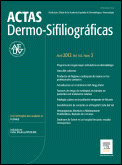
Actas Dermo-Sifiliograficas
Pioneering Research in Skin Health and DiseaseActas Dermo-Sifiliograficas, published by Elsevier España, stands as a pivotal resource in the realms of dermatology, histology, and pathology and forensic medicine. With its ISSN of 0001-7310 and E-ISSN 1578-2190, this esteemed journal has transitioned to an Open Access model since 2020, facilitating broader dissemination of impactful research. Operating from its Madrid headquarters, it has been a vital platform for scholarly exchange since its inception in 1945, continuing through its converged years until 2024. The journal holds a Q3 ranking in dermatology, histology, and pathology and forensic medicine as of 2023, reflecting its relevance in the academic community where it ranks 79th in dermatology and 126th in pathology among its peers. With a commitment to advancing knowledge and practice in its fields, Actas Dermo-Sifiliograficas serves as an essential repository for researchers, professionals, and students seeking to engage with the latest findings and innovative perspectives in skin and disease research.
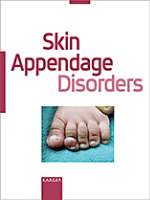
Skin Appendage Disorders
Advancing Knowledge in Skin Health and DisordersSkin Appendage Disorders, published by KARGER, is an esteemed academic journal focusing on the intricate realm of dermatology, particularly the structure and function of skin appendages. Established in 2016 and projected to continue through 2024, this journal has swiftly gained recognition, securing a respectable Q2 ranking in the field of Dermatology as of 2023, and achieving a Scopus rank of 76 out of 142 in the same category. With an ISSN of 2296-9195 and an E-ISSN of 2296-9160, the journal presents a platform for innovative research and clinical findings that address the multifaceted aspects of skin appendage disorders. Researchers, practitioners, and students will find significant value in its open access model, which encourages widespread dissemination of knowledge and fosters collaboration within the dermatological community. By publishing high-quality peer-reviewed articles, Skin Appendage Disorders aims to elevate the understanding of dermatological conditions and contribute to advancements in therapeutic practices, making it a vital resource for those dedicated to skin health.